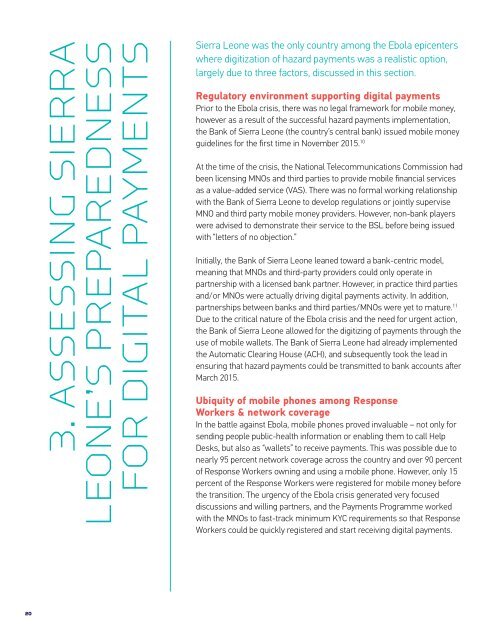LEONE
1U6Dtu2
1U6Dtu2
You also want an ePaper? Increase the reach of your titles
YUMPU automatically turns print PDFs into web optimized ePapers that Google loves.
3. ASSESSING SIERRA<br />
<strong>LEONE</strong>’S PREPAREDNESS<br />
FOR DIGITAL PAYMENTS<br />
Sierra Leone was the only country among the Ebola epicenters<br />
where digitization of hazard payments was a realistic option,<br />
largely due to three factors, discussed in this section.<br />
Regulatory environment supporting digital payments<br />
Prior to the Ebola crisis, there was no legal framework for mobile money,<br />
however as a result of the successful hazard payments implementation,<br />
the Bank of Sierra Leone (the country’s central bank) issued mobile money<br />
guidelines for the first time in November 2015. 10<br />
At the time of the crisis, the National Telecommunications Commission had<br />
been licensing MNOs and third parties to provide mobile financial services<br />
as a value-added service (VAS). There was no formal working relationship<br />
with the Bank of Sierra Leone to develop regulations or jointly supervise<br />
MNO and third party mobile money providers. However, non-bank players<br />
were advised to demonstrate their service to the BSL before being issued<br />
with “letters of no objection.”<br />
Initially, the Bank of Sierra Leone leaned toward a bank-centric model,<br />
meaning that MNOs and third-party providers could only operate in<br />
partnership with a licensed bank partner. However, in practice third parties<br />
and/or MNOs were actually driving digital payments activity. In addition,<br />
partnerships between banks and third parties/MNOs were yet to mature. 11<br />
Due to the critical nature of the Ebola crisis and the need for urgent action,<br />
the Bank of Sierra Leone allowed for the digitizing of payments through the<br />
use of mobile wallets. The Bank of Sierra Leone had already implemented<br />
the Automatic Clearing House (ACH), and subsequently took the lead in<br />
ensuring that hazard payments could be transmitted to bank accounts after<br />
March 2015.<br />
Ubiquity of mobile phones among Response<br />
Workers & network coverage<br />
In the battle against Ebola, mobile phones proved invaluable – not only for<br />
sending people public-health information or enabling them to call Help<br />
Desks, but also as “wallets” to receive payments. This was possible due to<br />
nearly 95 percent network coverage across the country and over 90 percent<br />
of Response Workers owning and using a mobile phone. However, only 15<br />
percent of the Response Workers were registered for mobile money before<br />
the transition. The urgency of the Ebola crisis generated very focused<br />
discussions and willing partners, and the Payments Programme worked<br />
with the MNOs to fast-track minimum KYC requirements so that Response<br />
Workers could be quickly registered and start receiving digital payments.<br />
20



